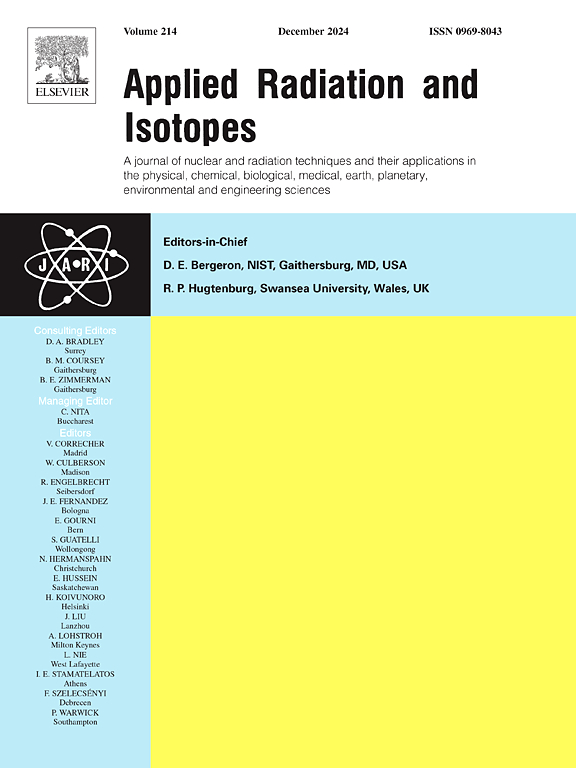In silico Monte Carlo with novel particle tagging: Assessing gold radiosensitivity in voxelized scenario of brachytherapy
IF 1.6
3区 工程技术
Q3 CHEMISTRY, INORGANIC & NUCLEAR
引用次数: 0
Abstract
Radiotherapy is widely acknowledged as one of the most effective treatments for solid and metastatic tumors. The sensitivity of tissues or cells to radiation is typically estimated using survival curves derived from laboratory experiments with in vitro cell culture models. However, some radioresistant cancer cells can pose significant treatment challenges. High atomic number (Z) nanoparticles, known as radiosensitizing agents, can induce substantial radiosensitization when positioned near therapeutic targets, resulting in a dose increase unattainable by conventional methods. This effect is associated with the emission of secondary electrons by high atomic number materials, effectively transforming them into secondary radiation sources. This study utilized a high-resolution voxelized computational model of an in vitro culture medium to investigate the insertion and impact of gold particles. Monte Carlo code (MCNP6.2) was used to model and simulate a brachytherapy scenario with a High Dose Rate (HDR) 192Ir source in a matrix of stop positions. The radiosensitivity of gold particles was evaluated using the dose enhancement factor (DEF), calculated based on the concentration of gold nanoparticle (AuNP) clusters in the culture medium (mg-AuNP/g) and the energy dependence in the in vitro samples. Simulations demonstrated a proportional relationship between DEF and concentration, enabling the creation of a predictive equation for DEF values, which was validated against published data. Additionally, energy was found to significantly influence DEF values. The DEF versus energy curve obtained exhibits similarities to the curve of the Sensitizer Enhancement Ratio (SER) versus dose, though the two differ in their determinants. SER is determined through various radiobiological mathematical models based on the biological effect derived from the fractional survival curve as a function of dose response. Furthermore, a special TAG tally was employed to identify the types of secondary electron (photoelectrons, Auger electrons and knock-on electrons and Compton scattering) production in the medium, their physical contributions, and their behavior at different energy sources of 100 keV, 192Ir and 1 MeV.
用新型粒子标记的计算机蒙特卡罗:评估近距离治疗体素化场景中的金放射敏感性
放射治疗被广泛认为是治疗实体瘤和转移瘤最有效的方法之一。组织或细胞对辐射的敏感性通常是用体外细胞培养模型的实验室实验得出的生存曲线来估计的。然而,一些放射耐药的癌细胞会给治疗带来重大挑战。高原子序数(Z)纳米粒子被称为放射增敏剂,当放置在治疗靶点附近时,可以诱导大量的放射增敏,从而导致常规方法无法达到的剂量增加。这种效应与高原子序数材料的二次电子发射有关,有效地将其转化为二次辐射源。本研究利用体外培养基的高分辨率体素化计算模型来研究金颗粒的插入和影响。使用蒙特卡罗代码(MCNP6.2)在停止位置矩阵中对高剂量率(HDR) 192Ir源的近距离治疗场景进行建模和模拟。利用剂量增强因子(DEF)评估金颗粒的放射敏感性,该因子是根据培养液中金纳米颗粒(AuNP)簇的浓度(mg-AuNP/g)和体外样品的能量依赖性计算的。模拟显示了DEF和浓度之间的比例关系,从而可以创建DEF值的预测方程,并根据已发布的数据进行验证。此外,能量对DEF值有显著影响。所得的DEF与能量曲线与增敏剂增强比(SER)与剂量曲线相似,尽管两者的决定因素不同。SER是通过各种放射生物学数学模型来确定的,这些模型是基于分数生存曲线作为剂量反应的函数得出的生物效应。此外,采用特殊的TAG计数方法鉴定了介质中产生的二次电子(光电子、俄歇电子、撞击电子和康普顿散射)的类型、它们的物理贡献以及它们在100 keV、192Ir和1 MeV不同能量源下的行为。
本文章由计算机程序翻译,如有差异,请以英文原文为准。
求助全文
约1分钟内获得全文
求助全文
来源期刊

Applied Radiation and Isotopes
工程技术-核科学技术
CiteScore
3.00
自引率
12.50%
发文量
406
审稿时长
13.5 months
期刊介绍:
Applied Radiation and Isotopes provides a high quality medium for the publication of substantial, original and scientific and technological papers on the development and peaceful application of nuclear, radiation and radionuclide techniques in chemistry, physics, biochemistry, biology, medicine, security, engineering and in the earth, planetary and environmental sciences, all including dosimetry. Nuclear techniques are defined in the broadest sense and both experimental and theoretical papers are welcome. They include the development and use of α- and β-particles, X-rays and γ-rays, neutrons and other nuclear particles and radiations from all sources, including radionuclides, synchrotron sources, cyclotrons and reactors and from the natural environment.
The journal aims to publish papers with significance to an international audience, containing substantial novelty and scientific impact. The Editors reserve the rights to reject, with or without external review, papers that do not meet these criteria.
Papers dealing with radiation processing, i.e., where radiation is used to bring about a biological, chemical or physical change in a material, should be directed to our sister journal Radiation Physics and Chemistry.
 求助内容:
求助内容: 应助结果提醒方式:
应助结果提醒方式:


